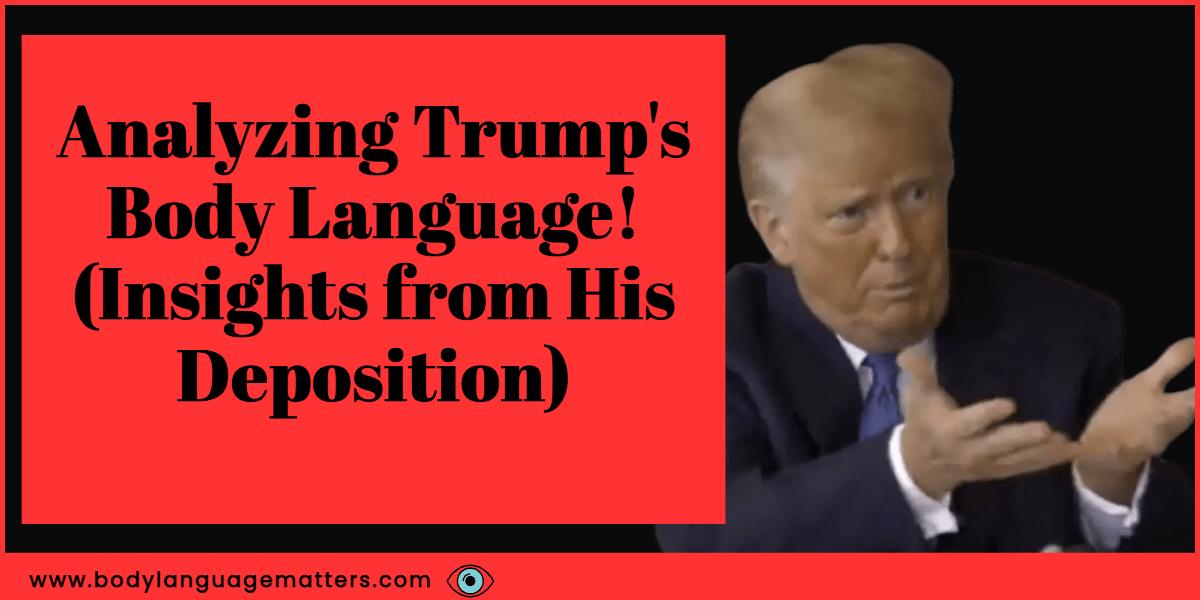Analyzing Trump’s Body Language: Insights from His Deposition ?
Donald Trump’s body language has been a subject of much scrutiny and interest for both his supporters and critics. One particularly fascinating moment to examine is his taped deposition in the E Gene Carroll case, where she accused him of rape in the 1990s. In this article, we will take a closer look at some of the insights that can be gained from analyzing Trump’s body language in this context.
Trump’s Social Life in the 80s and 90s
During the deposition, Trump was asked about his social life in the 80s and 90s, particularly his attendance at benefits, galas, and charity events. He acknowledged that there would often be a photography line at these events and that people would take photographs that would later be published.
This information is useful for understanding the context in which Trump’s body language was captured in these photographs. It also gives us insight into his social life and the types of events he was likely to attend during this period.
Trump’s Common Tells?
One of the most interesting aspects of analyzing Trump’s body language is identifying his common tells. These are gestures or behaviors that he tends to exhibit frequently, and that can give us insight into his emotional state.
Some of Trump’s most common tells, according to the analysis of his body language, include a sharp inhale, digital flexion object control, head tilt combined with an eye flutter, full body tilts, dominant shoulder retreat, and a chin thrust. These tells can indicate stress, confidence, or other emotional states.
Cognitive Bias and Political Beliefs ?
When analyzing body language, it’s important to be aware of cognitive bias and how it can impact our interpretations. This is particularly relevant in the case of Trump, where political beliefs can influence how people interpret his body language.
For example, some people may be inclined to interpret any negative body language from Trump as evidence of deception, while others may be more likely to overlook or excuse negative body language because of their support for him. It’s important to approach body language analysis with an open mind and avoid letting political beliefs cloud our interpretation.
Questioning Techniques and Body Language ⚠️
Finally, it’s worth noting that the way questions are asked can impact a person’s body language. In the case of Trump’s deposition, some observers have criticized the questioning techniques used, which may have led to limited use of illustrators and other body language cues.
For example, the interviewer’s purse lips and swaying could be interpreted as signs of disagreement or an alternate outcome, but it’s also possible that they were simply reacting to the questioning techniques. When analyzing body language, it’s important to consider the context in which it occurs and how outside factors may influence it.
The Expert’s Analysis
The analysis begins with Trump’s quick shoulder shrug when asked about his activities in the evenings. We note that this gesture suggests uncertainty or forgetfulness, indicating that Trump may not be entirely sure about his answer. However, overall, Trump appears unconcerned and at ease during the questioning, which is a common thread throughout the videos.
Trump is also observed using the desk to lean on and support himself comfortably, with his hand gripping his forearm in a gesture of relaxation. We then note that this position suggests Trump has found a comfortable spot and feels psychologically safe, which is reflected in his calm demeanor.
Throughout the questioning, Trump adapts his body language to match his thoughts, with his mouth moving as he listens to the questions and formulates his answers. However, we then note that Trump’s overall posture and grip on his forearm remain consistent, indicating that he is comfortable with the line of questioning and not feeling particularly defensive or uncomfortable.
As the deposition continues, Trump exhibits some discomfort around the topics of news shows and politics.
Furthermore, identifying Trump’s common tells is another interesting aspect of body language analysis. These gestures or behaviors that he frequently exhibits can provide insight into his emotional state. For instance, some of Trump’s most common tells include sharp inhales, digital flexion object control, head tilts combined with eye flutters, full body tilts, dominant shoulder retreats, and chin thrusts, which can indicate stress, confidence, or other emotional states.
However, it’s important to be aware of cognitive bias and how it can impact our interpretation when analyzing body language. In the case of Trump, political beliefs can influence how people interpret his body language. People may be inclined to interpret negative body language from Trump as evidence of deception, while others may overlook or excuse negative body language because of their support for him. Therefore, it’s crucial to approach body language analysis with an open mind and avoid letting political beliefs cloud our interpretation.
It’s also worth noting that the way questions are asked can impact a person’s body language. In Trump’s deposition, some observers criticized the questioning techniques used, which may have led to limited use of illustrators and other body language cues. For example, the interviewer’s purse lips and swaying could be interpreted as signs of disagreement or an alternate outcome, but it’s also possible that they were simply reacting to the questioning techniques. When analyzing body language, it’s important to consider the context in which it occurs and how outside factors may influence it.
In Conclusion
In conclusion, analyzing Trump’s body language in his deposition can provide valuable insights into his emotional state and attitudes. It’s important to approach this analysis with an open mind and be aware of how cognitive bias and other factors can impact our interpretations. By examining his movements and gestures during this legal proceeding, we can gain a better understanding of his demeanor and emotional state.

